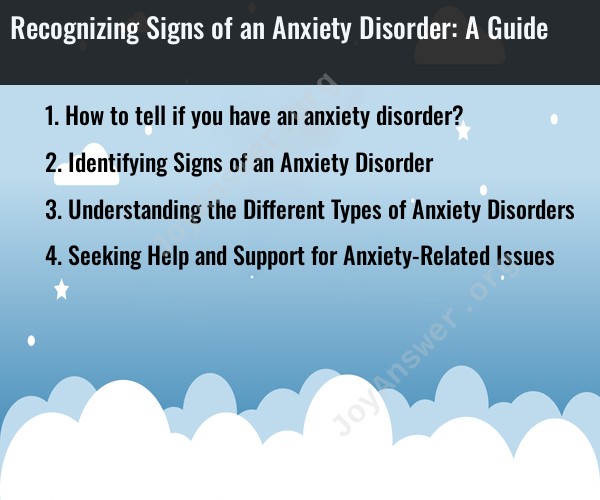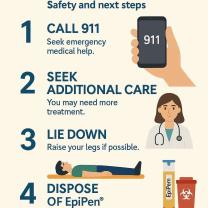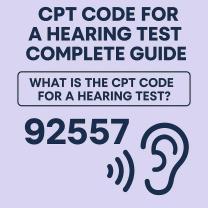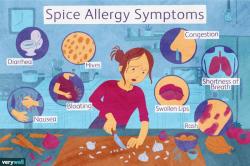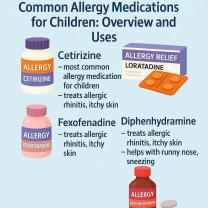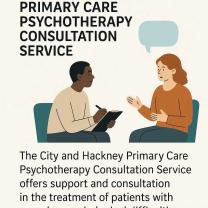How to tell if you have an anxiety disorder?
Recognizing the signs of an anxiety disorder can be an essential first step in seeking help and managing your mental health. Anxiety disorders are characterized by excessive and persistent worry, fear, or anxiety that can significantly interfere with daily life. If you suspect you may have an anxiety disorder, here are some signs to look for:
Excessive Worry: Constant and excessive worrying about everyday issues, often with no clear reason or cause.
Physical Symptoms: Anxiety can manifest as physical symptoms, including:
- Muscle tension
- Rapid heartbeat
- Trembling or shivering
- Shortness of breath
- Sweating
- Upset stomach or gastrointestinal issues
- Fatigue
Irrational Fears: Experiencing intense and irrational fears, phobias, or avoidance of certain situations, objects, or activities.
Panic Attacks: Sudden and intense episodes of fear or panic, accompanied by physical symptoms such as a racing heart, shortness of breath, and a sense of impending doom.
Sleep Disturbances: Difficulty falling asleep, staying asleep, or experiencing restless and disturbed sleep.
Social Anxiety: Extreme fear of social situations or performance situations, leading to avoidance of these scenarios.
Constant Overthinking: Overanalyzing situations, events, or conversations, often expecting the worst outcome.
Perfectionism: Setting unrealistic standards for yourself and experiencing distress when those standards aren't met.
Irritability: Feeling irritable, on edge, or easily agitated, even in situations that typically wouldn't provoke such reactions.
Physical Symptoms Unexplained by Medical Conditions: Experiencing physical symptoms, such as headaches or stomachaches, that persist without a clear medical cause.
Avoidance Behavior: Going to great lengths to avoid situations or places that trigger anxiety.
Procrastination: Putting off tasks or responsibilities due to anxiety about the outcome.
Nervous Habits: Developing nervous habits or rituals, such as nail-biting or hair-pulling, as a way to cope with anxiety.
Difficulty Concentrating: Finding it hard to focus or concentrate on tasks because of racing thoughts and worry.
Feeling Overwhelmed: Feeling overwhelmed by everyday responsibilities and having difficulty managing them.
It's important to note that experiencing some anxiety is a normal part of life, especially in response to stressful or challenging situations. However, when anxiety becomes chronic, excessive, and interferes with daily functioning, it may indicate an anxiety disorder.
If you suspect you have an anxiety disorder, it's crucial to seek professional help. A mental health professional, such as a psychologist, psychiatrist, or counselor, can provide a diagnosis and recommend appropriate treatment options, which may include therapy, medication, or a combination of both. You don't have to face anxiety disorders alone, and treatment can be highly effective in helping you manage your symptoms and improve your quality of life.
Identifying Signs of an Anxiety Disorder
Anxiety is a normal and often healthy emotion. However, when a person regularly feels disproportionate levels of anxiety, it may be a sign of an anxiety disorder.
Some common signs of an anxiety disorder include:
- Excessive worry or apprehension
- Feeling restless, wound-up, or on-edge
- Having trouble concentrating or mind racing
- Having difficulty sleeping
- Irritability
- Muscle tension
- Fatigue
- Headaches, stomachaches, or other physical symptoms
- Avoidance of situations that trigger anxiety
If you experience some or all of these symptoms on a regular basis, and they are causing significant distress or impairment in your life, it is important to seek professional help.
Understanding the Different Types of Anxiety Disorders
There are several different types of anxiety disorders, each with its own unique set of symptoms. Some of the most common types of anxiety disorders include:
- Generalized anxiety disorder (GAD): GAD is characterized by excessive and uncontrollable worry about a variety of things, both big and small.
- Social anxiety disorder (SAD): SAD is characterized by a fear of social situations and interactions. People with SAD may worry about being judged, embarrassed, or humiliated in social situations.
- Panic disorder: Panic disorder is characterized by sudden and unexpected panic attacks. Panic attacks are episodes of intense fear that are accompanied by physical symptoms such as a racing heart, shortness of breath, and chest pain.
- Specific phobias: Specific phobias are characterized by an intense and irrational fear of a specific object or situation.
- Obsessive-compulsive disorder (OCD): OCD is characterized by unwanted and intrusive thoughts (obsessions) and repetitive behaviors or mental acts (compulsions).
- Post-traumatic stress disorder (PTSD): PTSD is a mental health condition that can develop after a person experiences or witnesses a traumatic event. Symptoms of PTSD can include flashbacks, nightmares, anxiety, and avoidance of reminders of the trauma.
Seeking Help and Support for Anxiety-Related Issues
If you are struggling with anxiety, there are a number of things you can do to get help and support. Here are a few tips:
- Talk to your doctor or a mental health professional. They can assess your symptoms and make a diagnosis. They can also recommend treatment options, such as therapy and medication.
- Join a support group. Support groups can provide a safe and supportive environment where you can connect with other people who are struggling with anxiety.
- Learn about anxiety and coping mechanisms. There are a number of books, websites, and other resources that can teach you about anxiety and how to cope with it.
- Make lifestyle changes. There are a number of lifestyle changes that can help to reduce anxiety, such as getting regular exercise, eating a healthy diet, and getting enough sleep.
If you are struggling with anxiety, it is important to remember that you are not alone. There are a number of resources available to help you get the support you need.
